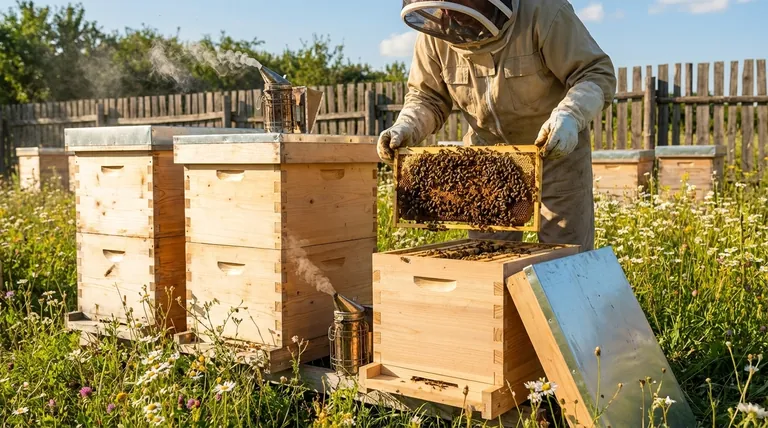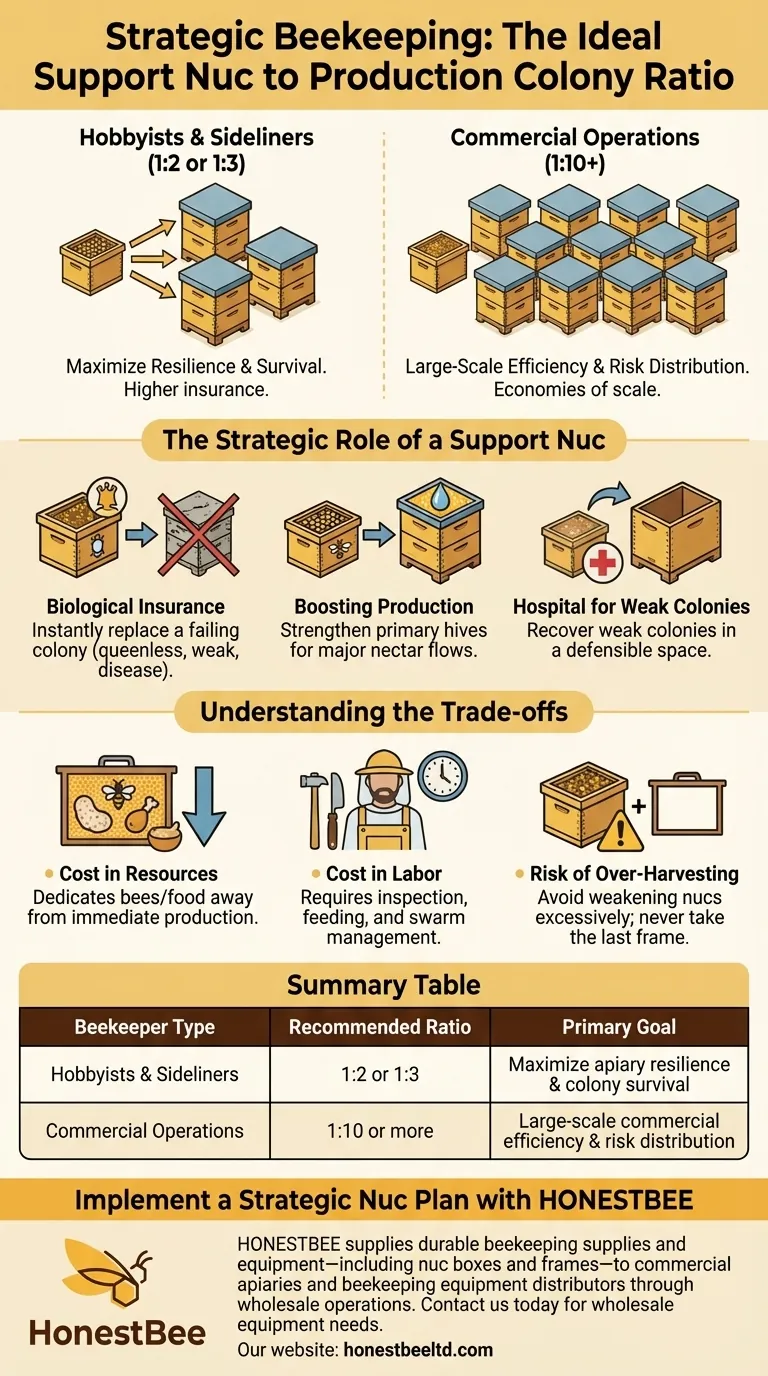For most beekeepers, the recommended ratio is one support nucleus colony (nuc) for every two to three full-size production colonies. This ratio provides a balance between resource investment and operational resilience. Commercial operators, who manage risk at a much larger scale, may maintain a lower ratio, such as one nuc for every ten or more production hives.
A support nuc is not just an extra hive; it is a strategic tool for proactive apiary management. The ideal ratio depends less on a magic number and more on your specific goals, whether they are maximizing honey production, ensuring colony survival, or expanding your operation.

The Strategic Role of a Support Nuc
Thinking of a support nuc as mere "backup" is a mistake. It is an active resource generator that serves as your apiary's insurance policy and productivity engine.
A Source of "Biological Insurance"
The most critical function of a support nuc is to replace a failing colony. If a production hive becomes queenless, weak, or succumbs to disease, a healthy nuc with a laying queen can be used to replace it instantly, preventing a total loss.
Boosting Production Colonies
You can systematically strengthen your primary hives by using resources from your support nucs. By periodically moving a frame of brood and nurse bees (leaving the queen in the nuc) into a production colony, you boost its population right before a major nectar flow, significantly increasing its foraging workforce.
A Hospital for Weak Colonies
A weak colony struggling in a large, full-size hive box is vulnerable to pests like wax moths and small hive beetles. Moving that colony into a smaller nuc box allows it to defend its space more effectively while you help it recover.
Determining Your Ideal Ratio
The standard advice varies because the goals of a hobbyist and a commercial beekeeper are fundamentally different. Your ratio should reflect your operational scale and tolerance for risk.
For Hobbyists and Sideliners (1:2 or 1:3)
For beekeepers managing a smaller number of hives, the loss of even one colony is a significant setback. Maintaining a higher ratio of one nuc for every two or three hives provides robust insurance and ample resources for boosting your primary honey producers.
For Commercial Operations (1:10+)
Commercial beekeepers operate on economies of scale. While they also use nucs, their risk is distributed across hundreds or thousands of colonies. They can absorb individual losses more easily and often create nucs in large batches as part of their overall business model, leading to a much lower support-to-production ratio.
Understanding the Trade-offs
Maintaining support nucs is an investment, not a free benefit. Understanding the costs involved is crucial for making an informed decision.
The Cost in Resources
Every frame of bees, brood, and food dedicated to a support nuc is a frame not present in a production colony. You are trading some immediate production potential for long-term stability and resilience.
The Cost in Labor
Nucs require management. They need to be inspected for health, fed during dearths, and managed to prevent them from swarming. This adds to your overall workload.
The Risk of Over-Harvesting
When using nucs to boost other colonies, you must be careful not to weaken them excessively. Taking too much brood or bees can cause the nuc itself to fail, defeating its purpose as a support unit. A good rule is to never take the last frame of brood.
Making the Right Choice for Your Goal
The correct ratio is the one that aligns with your specific objectives as a beekeeper. Use these guidelines to find your starting point.
- If your primary focus is apiary resilience and colony survival: A 1:2 ratio offers the most robust insurance against colony loss.
- If your primary focus is balancing honey production with a strong safety net: A 1:3 ratio is an efficient and widely practiced standard for sideliners.
- If your primary focus is large-scale commercial efficiency: Your ratio will be much lower (1:10 or more) and dictated by your specific business model for pollination or honey production.
Ultimately, integrating support nucs into your apiary is a shift from reactive problem-solving to proactive, strategic management.
Summary Table:
| Beekeeper Type | Recommended Ratio (Support Nucs : Production Colonies) | Primary Goal |
|---|---|---|
| Hobbyists & Sideliners | 1 : 2 or 1 : 3 | Maximize apiary resilience and colony survival |
| Commercial Operations | 1 : 10 or more | Large-scale commercial efficiency and risk distribution |
Ready to implement a strategic nuc management plan and build a more resilient, productive apiary?
HONESTBEE supplies durable beekeeping supplies and equipment—including nuc boxes and frames—to commercial apiaries and beekeeping equipment distributors through our wholesale-focused operations. Our high-quality equipment is designed to support your proactive management strategy, helping you maintain healthy support nucs and maximize honey production.
Contact HONESTBEE today to discuss your wholesale equipment needs and strengthen your operation's foundation.
Visual Guide

Related Products
- 5 Frame Wooden Nuc Box for Beekeeping
- Twin Queen Styrofoam Honey Bee Nucs Mating and Breeding Box
- Automatic Heat Preservation 6 Frame Pro Nuc Box for Honey Bee Queen Mating
- Styrofoam Mini Mating Nuc Box with Frames Feeder Styrofoam Bee Hives 3 Frame Nuc Box
- Portable Bee Mating Hive Boxes Mini Mating Nucs 8 Frames for Queen Rearing
People Also Ask
- What is a common feature of many 5-frame nuc boxes? The Integrated Feeder for Efficient Colony Growth
- What is the advantage of overwintering a nucleus? A Strategic Asset for Beekeeping Success
- How should the nuc be installed in the apiary? Ensure Colony Success from Day One
- How many frames does a typical wooden nuc box hold? A Guide to Choosing the Right Size
- What are the benefits of using nucs for beginning beekeepers? Ensure a Successful First Hive with a Head Start



















